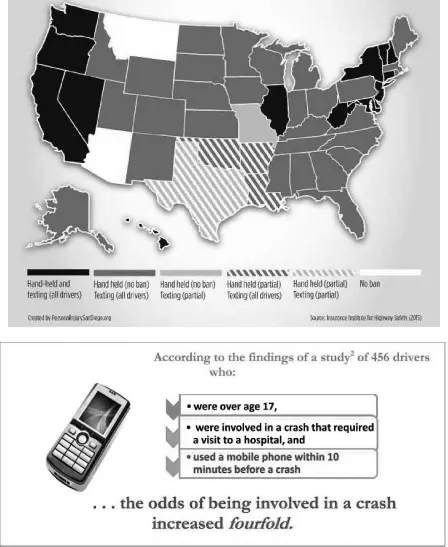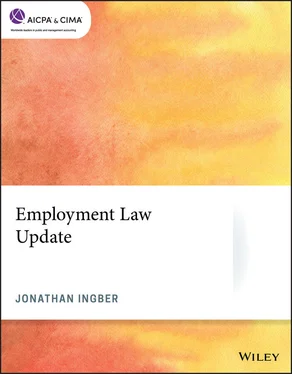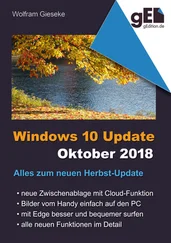 Case study 2-1: You are the judge
Case study 2-1: You are the judge
Bob worked as a senior executive for an insurance company, TBG. Bob was provided two computers by TBG, one for use at work and one for use at home. Bob signed TBG's “electronic and telephone equipment policy statement” that stated the computers would not be used for “improper, derogatory, defamatory, obscene, or other inappropriate purposes.” Three days before Bob would become vested in TBG shares worth over $1.2 million, TBG terminated him for “repeatedly accessing” explicit websites on the internet while he was at work.
Bob sued TBG for wrongful termination, claiming the inappropriate websites popped up involuntarily. In response, TBG moved to compel Bob to produce the home computer, saying it wanted that computer to confirm whether Bob had accessed similar websites from his home computer. Bob argued that the home computer had personal email and other information that belonged to him, his wife, and children, and that he had a reasonable expectation of privacy while using the home computer. He also accused TBG of using a “scorched earth” litigation strategy, noting that he and other TBG executives anticipated that home computers would be used for personal purposes and were “perks” provided to senior executives. TBG argued that Bob could not seriously claim he had a reasonable expectation of privacy, having signed the electronic and telephone equipment policy statement.
You are the judge in the case. How would you decide the issue? 3
Driving and cell phone use
Most companies use the APA, defined earlier, to inform employees that they are required to use mobile communications devices in hands-free mode (where the law permits), and inform employees of their obligations under the law. The APA usually includes language that encourages limiting personal calls, prohibits texting, emailing, instant messaging, or tweeting while driving, and informs employees of safety measures to employ while driving and talking on a cell phone. The following map illustrates the status of state laws that ban or restrict cell phone use and texting as of 2015, based on information from the Insurance Institute for Highway Safety.
 S.P. McEvoy, M.R. Stevenson, A.T. McCartt, M. Woodward, C. Haworth, P. Palamara, and R. Cercarelli, “Role of mobile phones in motor vehicle crashes resulting in hospital attendance: a case-crossover study.” BMJ (2005): 331, http://dx.doi.org/10.1136/bmj.38537.397512.55. Accessed January 6, 2018.
S.P. McEvoy, M.R. Stevenson, A.T. McCartt, M. Woodward, C. Haworth, P. Palamara, and R. Cercarelli, “Role of mobile phones in motor vehicle crashes resulting in hospital attendance: a case-crossover study.” BMJ (2005): 331, http://dx.doi.org/10.1136/bmj.38537.397512.55. Accessed January 6, 2018.
The National Safety Council (NSC) estimated in 2014 that 10% of U.S. accidents involved distracted driving, of which 13% involved a cell phone in use. The NSC estimates were compiled due to the belief that drivers significantly underreported cell phone use in crashes.
If an employee is involved in an accident and is ticketed or found to be at fault, the employer should expect to receive a subpoena in any later litigation for ( a ) company-owned cell phone billing records and ( b ) driving data (speed, braking distance and force applied, steering corrections, and direction) from immediately before the accident that was recorded by the car's computer system. The employer may have a defense if the employee was not driving his or her car for business purposes at the time of the accident, but that defense will be seriously compromised if the employee was talking on a smartphone with a customer, supplier, coworker, or other work-connected party at the time of the accident. Put another way, plaintiffs' lawyers will seek ways to add the employer as a co-defendant where the circumstances allow. This is because businesses carry insurance policies that typically have higher policy limits than do individual policies, and a larger company is perceived as a deep-pocket defendant that can afford to pay a judgment if it exceeds policy limits.
1 Having employees sign an APA that acknowledges the employer may monitor the employees' internet use is critical becauseThe employer cannot otherwise monitor the employees' internet use.The APA is an enforceable agreement.The APA removes the expectation of privacy.The employee can use the employer's internet for purely personal purposes.
 Exhibit 2-1 Is hands-free cellphone use the answer?
Exhibit 2-1 Is hands-free cellphone use the answer?
An employee for a multinational beverage company was driving a company vehicle in Corpus Christi, Texas, in 2010 and talking on a hands-free headset. The employee thought she had a green turn arrow and turned left, crushing a Ford Fusion being driven by Ms. Chatman-Wilson.
As a result, Ms. Chatman-Wilson suffered permanent nerve damage in her back, had to undergo back surgery, and was unable to return to work. The beverage company maintained that it had a cell phone policy that required drivers to use a hands-free device while driving, which the employee had done. The beverage company also stated that its cell phone policy actually exceeded the state law requirement pertaining to driving and talking on a cell phone.
Ms. Chatman-Wilson's attorneys introduced evidence during trial that demonstrated that even drivers using hands-free cell phones suffer a 37% “cognitive distraction” while engaged in a phone call while driving. Also during trial:
The employee-driver testified that she was not aware of the serious risks of distracted driving while using a cell phone, and that if she had been made aware of those risks by her employer, she would not have used her phone while driving.
The beverage company was alleged to have known about the dangers of driving and talking on even a hands-free device, but did not share that with employees — only with the heads of its regional offices.
If you were on the jury, would you vote to hold the employer liable?
If so, what would you award Ms. Chatman-Wilson?
Would the result be different if the company had a “no cell phone use while driving” policy?
2017 Update: California prohibits driving while holding a cell phone
Effective January 1, 2017, California Vehicle Code Section 23123.5 prohibits California drivers from holding cell phones while they drive. The law prohibits holding a cell phone while driving for any purpose, including voice calls, checking maps, texting, taking pictures, playing videos, accessing the internet, or for any other reason. Cell phone use while driving is permitted if the cell phone is dash-mounted and set up for voice activation or hands-free use.
GPS and location tracking
With the proliferation of smartphones and GPS-equipped laptops, tablets, and other devices that enable a device's location to be tracked, the opportunities to monitor an employee's location via device monitoring are extensive. Many cars also are equipped with GPS, and virtually all cars manufactured post-2008 have software that records the car's speed, direction, and braking history immediately prior to an accident. Again, if an employer anticipates tracking employee locations using a device or automotive GPS, the employer would be wise to obtain the employee's acknowledgment to this monitoring in the APA to ensure that the employee cannot assert a privacy right pertaining to his or her location or the location of the device. In some states such as California, Illinois, Minnesota, Tennessee, and Texas, state law prohibits the use of mobile tracking technologies without the consent of the owner of the device or vehicle. Although the company's use of tracking information could be deemed as “company consent,” having the employee sign an APA that acknowledges the right of the employer to use GPS to track the location of the device or vehicle will avoid any later claim that the employee's consent was not obtained. In legal terms, the employee's signature on the APA demonstrates that the employee had notice of, and consented to, the company's right to use GPS to monitor the location of the device or vehicle (and thus the employee's location, at least when the employee is carrying the device or in the vehicle).
Читать дальше

 Case study 2-1: You are the judge
Case study 2-1: You are the judge S.P. McEvoy, M.R. Stevenson, A.T. McCartt, M. Woodward, C. Haworth, P. Palamara, and R. Cercarelli, “Role of mobile phones in motor vehicle crashes resulting in hospital attendance: a case-crossover study.” BMJ (2005): 331, http://dx.doi.org/10.1136/bmj.38537.397512.55. Accessed January 6, 2018.
S.P. McEvoy, M.R. Stevenson, A.T. McCartt, M. Woodward, C. Haworth, P. Palamara, and R. Cercarelli, “Role of mobile phones in motor vehicle crashes resulting in hospital attendance: a case-crossover study.” BMJ (2005): 331, http://dx.doi.org/10.1136/bmj.38537.397512.55. Accessed January 6, 2018. Exhibit 2-1 Is hands-free cellphone use the answer?
Exhibit 2-1 Is hands-free cellphone use the answer?










